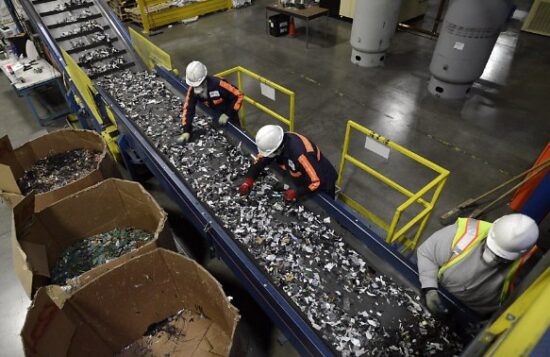Please welcome Christy Young and her contribution to this blog. Christy is just getting started in her new career as a freelance writer. Her interests are on business, marketing, branding and real estate. In this her first contribution to 21st Century Tech Blog she writes about the growing problem of digital waste.
I don’t know about you but this is a problem evident in my home as I am sure it is for many of you. Our apartment’s storage locker has a growing pile of discarded electronics including a netbook, digital projector, electronic writing board, several hard drives for which I have no use, modems, range extenders and cables. And here in the den where I do most of my writing, a discarded Chromebook sits abandoned on a shelf, while several old mobile phone models are stashed in a desk drawer. When we move sometime next year I will need to clear out all these items and bring them to a special electronic waste disposal site and who knows what will happen to them after that. It seems like such a waste.
That’s why this topic is an important one and I thank Christy for offering it to us to publish here. If you have similar tales or would like to comment please feel free to do so at the bottom of this web page.
According to a report by the United Nations of the 53.6 million tons of discarded electronic gadgets, only 17.4% were recycled. Digital waste is a significant source of environmental pollution causing potential health problems in adults and children exposed to the materials contained within them. And as consumers upgrade electronic devices and throw away old ones every year smartphones, computers, and laptops are ending up in landfills.
Today, many organizations are raising awareness about digital waste. Businesses are starting to take steps to recycle their old electronics properly. Why? Because digital can have damaging impacts on the environment.
Here are some reasons why you should focus on the problem right now.
- Digital Waste Releases Harmful Chemicals and Toxins – This is a major reason to pay attention to digital waste and its disposal. Electronics contain lots of metals, toxins, and chemicals that if improperly disposed of can leach into the ground and pollute the underlying aquifer as well as local surface water sources. Some of these toxins are linked to cancer and respiratory diseases. Today’s televisions, smartphones, laptops, and tablets contain harmful materials. Proactive companies as a result have started to look for safe disposal resources. Individuals and families can also access these types of resources if not local municipal and county electronic waste management initiatives. What you shouldn’t be doing is tossing this type of technology in the regular trash. Look for retailers offering trade-in programs that describe what will happen to your end-of-life device after you give it to them.
- Digital Waste Goes Into Dump Sites in Developing Countries – The Global South is increasingly being used as a garbage dump by rich countries. Disposing of digital waste is no exception. This is leading to an increase in environmental pollution and health concerns in African and Asian countries that accept digital waste. It ends up in poorly managed landfills near cities and small towns releasing toxic emissions into the water and air. And because nations in the Global South may not have state-of-the-art diagnostic and healthcare infrastructure, the diseases the digital waste causes is often poorly understood and therefore, treatments are ineffective.
- Digital Waste Contains Recoverable Valuable Materials – Many electronic gadgets such as smartphones and laptops contain valuable elements such as gold, aluminum, and silver. These can be recovered and reused to manufacture new digital products. This is becoming a growing business with many companies setting up recycling facilities to recover valuable metals. Reuse of these elements has a positive environmental impact as well reducing the need to mine for new materials. For the average consumer, a quick online search will help you find companies that may even buy back your obsolete digital devices to recover the valuable elements within them. So check it out before you throw it out.
- Old Digital Devices Can Still Have a Second Life and Save You Money – Recently Alphabet, Google’s parent company, announced the release of Chrome Flex, an operating system to extend the life of old laptop and desktop computers. Old electronics still have value, even devices that are five years old. (Editor’s Note: I am typing on a Dell desktop I purchased six years ago and only now with the release of Windows 11 which is incompatible with my system, am I beginning to see a potential end-of-life for this workhorse system.) So you may be able to save a lot of money by refurbishing or repairing old digital devices to prolong their use. Old electronics can be sold for cash or donated to charitable programs in your local community.
Treatment Options for Digital Waste
Can we implement e-waste recycling and reduce its growth? What would the world accomplish by implementing such strategies? Most of us when buying electronics don’t consider the long-term effects of these purchases. It is why digital waste ends up in landfills domestically or abroad. But the cost to the environment is significant and that’s why governments and non-profits are actively seeking to implement recovery, refurbishment, and reuse programs.
If you are not familiar with the term, the circular economy, it very much describes the digital waste paradigm being described here. Circular economies look at products and services from sourcing to end-of-life and develop strategies to optimize the use of resources to eliminate waste. Circular economies are all about sustainability and achieving net-zero carbon emissions.
As we direct our global efforts to mitigate climate change, rethinking digital waste within the context of circular economic principles makes sense. Companies and industries that source materials by upcycling old or used items to create new products are following these principles.
















